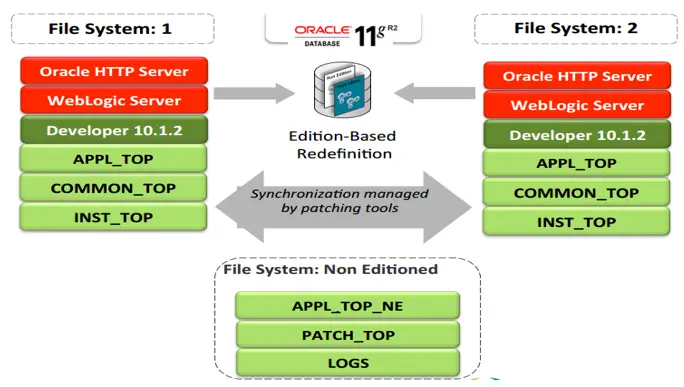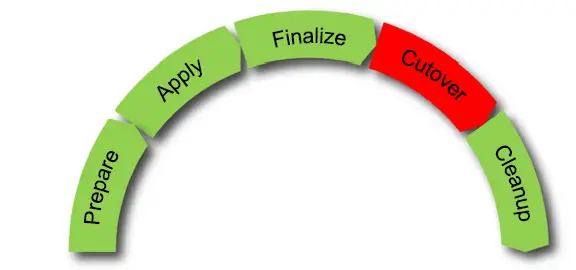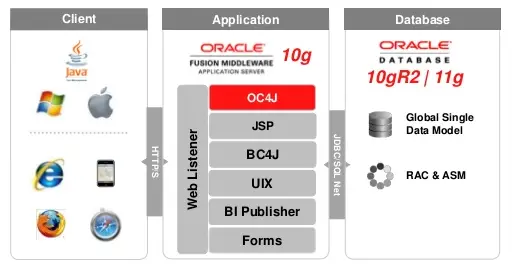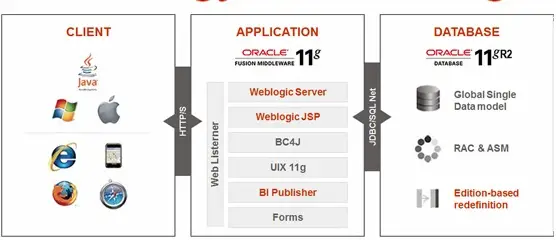R12.2 is the latest release in Oracle EBS area. The latest Patchset available is 12.2.13 We are presenting here the most sought over 40 question you must know about R12.2
Question 1: What is Online Patching?
Answer:
Online patching is a new patching mechanism that is available with R12.2 that allows the application of patches while the system is up and running, and the users are working as normal.
Question 2: Which Oracle E-Business Suite release Online Patching feature is available?
Answer Online patching is used with Oracle E-Business Suite 12.2 and higher.
Question 3: What types of patches are applied online?
Answer: All Oracle E-Business Suite Release 12.2 patches are applied online. This includes one-off patches, patch rollups, consolidated updates and security patches.
Question 4 What is the Online Patching cycle?
Answer: The Online Patching cycle is a sequence of interrelated steps (phases) used to apply patches to an Oracle E-Business Suite system.
Question 5 What tool is used to apply online patches?
Answer: The AD Online Patching (adop) command-line utility is used to manage the Online Patching cycle. adop invokes adpatch is the background only
Question 6: Is there any downtime in Online Patching?
Answer: There is a short period of downtime when the application tier services are shut down and restarted. The database remains open all the time.
Key technology changes in E-business Suite R12.2
Question 7 Once I upgrade to Release 12.2, can I still traditionally apply patches?
Answer: No. All patches for Release 12.2 will be online patches. The traditional, pre-12.2 method of applying patches will not work. There are options like downtime and hotpatch which work more like the traditional way but they are used for patches directed by Oracle
Question 8:What is the Online Patching infrastructure?
Answer: This infrastructure includes database objects edition and patch/run file system components.

Question 9. Does Online Patching require the 11gR2 Oracle Database Edition Based Redefinition (EBR) feature?
Answer Yes. Online patching depends on the Edition Based Redefinition (EBR) feature that was introduced in the Oracle 11gR2 Database. Most notably, EBR allows the editioning of code objects in the database. To do this, it provides new object types such as editions, editioning views, and cross-edition triggers, all of which are part of the Online Patching infrastructure.
R12.2 edition determination and setup
Question 10. What are the phases that make up the Online Patching cycle?
Answer: The Online Patching cycle consists of the following phases:
1. Prepare a virtual copy (patch edition) of the running application (run edition).
2. Apply patches to the patch edition of the application.
3. Finalize the system in readiness for the cutover phase.
4. Cutover to the patch edition and make it the new run edition.
5. Clean up obsolete definitions or data to recover space.

Oracle Ebuisness Suite Architecture in R12.2
Question 11. What downtime is required during an Online Patching cycle? Or as the name spells online, there is no downtime in the whole process
Answer The cutover phase requires a short period of downtime (typically a few minutes) for transition tasks such as a restart of the application tier services.
Question 12. Is any downtime required for the database tier?
Answer: No. The database needs to be up and running during each phase of the Online Patching cycle. Suite database.
Question 13. How does Online Patching work on the application tier?
Answer: During Release 12.2 installation, Rapid Install will lay down two copies of the application tier file system. One of the copies will be labeled as the run file system, and the other as the patch file system. Subsequently, when a patch is applied, adop will:
1. Synchronize the contents of the run file system to the patch file system. This happens during the preparation phase.
2. Perform patching actions on the patch file system. This happens during the apply phase.
3. Finally, during the cutover phase, the adop utility restarts the application tier services. The patch file system is then promoted to be the new run file system, and the old run file system becomes the patch file system for the next patching cycle.
Note that a third file system, the non-editioned file system (fs_ne), is created to store files containing data that is needed across all file systems, such as log files.
R12.2 Online Patching Cycle Summary
Question 14. How do I apply Oracle Fusion Middleware patches in Oracle E-Business Suite Release 12.2?
Answer: During the apply phase of an Online Patching cycle, you apply Oracle Fusion Middle-ware patches to the Oracle homes of the patch edition file system. Then, after the cutover phase is complete, you synchronize the file systems by performing a fs_clone operation.
How to apply the technology patches to EBS R12.2
Question 15. Can I use the patch edition for testing and development purposes?
Answer As a specialized component of the Online Patching infrastructure, the patch edition is not supported for use as a test environment. You should continue to employ a separate, dedicated test environment.
Question 16. Can Online Patching be used with database technologies such as Active Dataguard and Flashback?
Answer: Yes. Online patching can be used alongside Active Dataguard and Flashback. In fact we can use flashback to rollback the changes after the final cutover
Question 17. What are the key differences between the DBA_OBJECTS, DBA_OBJECTS_AE, and AD_OBJECTS tables?
Answer DBA_OBJECTS shows object information for the current edition, but the STATUS column in this view may show the object as VALID even if the object actually needs to be compiled before use.
DBA_OBJECTS_AE is similar to DBA_OBJECTS but shows object information across all editions. This has the drawback of showing objects in old editions that are no longer accessible to the application.
AD_OBJECTS is the Oracle E-Business Suite workaround to the unreliable STATUS column in DBA_OBJECTS. AD_OBJECTS shows the correct status for each object visible in the current edition. It also shows whether the object is “actual” (a real object) in the current edition, or a “stub” object (the object definition was inherited from a previous edition). You can query AD_OBJECTS to locate objects that need to be recompiled before use:
SQL>select owner, object_name, object_type from ad_objects where status = 'INVALID' order by 1,2,3 /
The same logic can be applied by running the script:
SQL>sqlplus apps/apps @$AD_TOP/sql/ADZDSHOWINVALID
Everything you would like to know about Create table in oracle
Oracle Indexes and index types
Question 18. Does Online Patching increase the network port requirements on an Oracle E-Business Suite instance?
Answer: Yes. Online patching requires an additional set of network ports for the Oracle WebLogic server-managed servers on the second file system. During the cutover phase, the managed servers run simultaneously on the patch file system and run file system for a brief period, in a rolling transition process.
Question 19. Is it possible to abort an Online Patching session?
Answer Yes. Up to cutover, you can run the abort phase to undo the changes made so far in the patching cycle. It is not possible to back out patches once the cutover is complete.
Question 20. Is the shared APPL_TOP configuration supported with Online Patching?
Answer: Yes. A shared APPL_TOP configuration is supported and recommended for multi-node application tier implementations in Release 12.2.
Question 21. How does adop work in a multi-node environment?
Answer The adop Online Patching tool uses remote APIs and ssh login to execute patching operations on remote nodes in a multi-node environment. The node that launches adop becomes the ‘master’ node, and the remote nodes are referred to as ‘slaves’.
Question 22. How do I determine the status of my Online Patching session?
Answer: You can run the adop -status command. This will display information that includes phases completed and the time taken. If you want additional details of operations performed, you can run the adop -status -detail command.
Question 23. What is downtime mode and when can it be used?
Answer: To optimize the process of upgrading to E-Business Suite Release 12.2, the AD Delta 5 Release Update Pack introduced downtime mode, which is used as follows:
$ adop phase=apply patches=<patch_number> apply_mode=downtime
Downtime mode does not use an online patching cycle. The process of applying a patch in downtime mode completes more quickly than in online mode, but at the cost of increased system downtime.
When applying Oracle E-Business Suite patches in this mode, adop will first confirm that the application tier services are down, and will then proceed to apply the patch to the run edition of the Oracle E-Business Suite database and file system.
Downtime mode is supported for:
-All patching (including post-upgrade patching) that forms part of the Release 12.2 upgrade process and is completed before the system is scaled up, the application tier services are started, and users log in to the upgraded system.
-Single-node development or test environments, where production support and high availability are not required.
Downtime mode allows the 12.2 upgrade process to be completed as quickly as possible. Once the upgrade is complete and users are online, all subsequent patching on a production system should use online mode, not downtime mode, unless the patch readme states otherwise.
Several restrictions apply to the use of downtime mode:
-You cannot validate a successful patch application before the cutover to the updated code takes place.
-There is no capability to abort a failed patch and return to the existing run edition.
-Release 12.2 patches are not normally tested in downtime mode.
-Use of downtime mode in a multi-node application tier environment is not tested or supported.
Question 24. What can I do to reduce the time required for cutover?
Answer: It is important to distinguish between the time needed for the whole cutover phase and the downtime period within the phase. The actual downtime (during which users cannot log in) is significantly shorter than the whole phase. To help reduce the overall time taken by cutover, you can do three things:
-Run the finalize phase explicitly, to obviate the need for cutover to do so.
-Shut down the concurrent managers before running cutover, to avoid having to wait for concurrent requests to complete. Alternatively, ensure no long-running concurrent jobs are submitted while a patching cycle is in progress.
-Ensure you are using the maximum number of parallel workers your system will support.
Question 25. What is fs_clone and how is it used?
Answer The command adop phase=fs_clone is a special command that is used to copy the run file system to the patch file system.
Question 26. Will AutoConfig and adadmin maintenance tasks such as adrelink, forms compilation, and report compilation be performed online?
Answer: Yes, these maintenance tasks will be performed online. The relevant operations will be targeted to the patch file system and should be performed during a patching cycle. They will not have any impact on the run file system.
Question 27. Does Online Patching change the way data fix patches are applied to Oracle E-Business Suite 12.2?
Answer Yes. Data fix patches (used to fix transactional data) require special handling. The patch readme will give full instructions.
Question 28 How do I apply or patch my customizations in Oracle E-Business Suite Release 12.2?
Answer You should apply your customizations to the patch edition during the apply phase of the Online Patching cycle. Because this happens prior to the cutover phase, your changes will be propagated to the new run edition (along with all the fixes in the patches applied during the patching cycle).
Question 29. If custom code is installed on a separate database schema, do I have to edition-enable my custom database schema?
Answer The coding standards in the Oracle E-Business Suite Developer’s Guide state that the first step to any custom application development is to register the custom Oracle schema with the Oracle E-Business Suite applications. The Online Patching enablement patch enables editioning on all the schemas registered with the application. If you follow this process, your schema will be edition-enabled automatically.
Question 30. Are there any special considerations for creating custom patches that are compliant with Online Patching?
Answer Yes. There are some special considerations for creating custom patches that are compliant with Online Patching. Refer to the Patching Standards section of Oracle E-Business Suite Developer’s Guide.
Question 31: How is a non-Oracle E-Business Suite database schema able to access the Oracle E-Business Suite tables?
Answer Any third-party schema, either from third-party products or custom code, must access Oracle E-Business Suite tables via the synonyms in the APPS schema. Direct access to Oracle E-Business Suite tables may produce incorrect results.
Question 32: What are the main technological differences between R12.2 and R12.1
Answer: R12.2 uses weblogic while R12.1 uses OC4J. Apart from that, we have an online patching feature in r12.2 using edition and patch/run file system
R12.1 Techstack

R12.2 techstack

Question 33: How to change the apps password in R12.2?
Answer: apps password is same as R12.1 with the exception of changing that in weblogic console also.
Question 34: where are the log files stored for adop?
Answer: It is stored in the third filesystem which is non edition filesystem
Question 35. how do you connect to the patch edition?
Answer: Source the env using the patch option
/u71/R122/EBSapps.env patch
Question 36: How to determine the weblogic version in R12.2
Answer How to find the Weblogic Version
Question 37. How to increase the managed node in R12.2?
Answer
How to add the manage server in R12.2
How to delete the manage server in R12.2
Question 38. Where are the log files located in R12.2 Apache and Weblogic
Answer
Apache Logs
$IAS_ORACLE_HOME/instances/*/diagnostics/logs/OHS/EBS_web_*/*log
OPMN Log
$IAS_ORACLE_HOME/instances/*/diagnostics/logs/OPMN/opmn/*
Weblogic Logs
$IAS_ORACLE_HOME/../wlserver_10.3/common/nodemanager $EBS_DOMAIN_HOME/servers/oa*/logs/* $EBS_DOMAIN_HOME/servers/forms*/logs/* $EBS_DOMAIN_HOME/servers/AdminServer/logs/* $EBS_DOMAIN_HOME/sysman/log/*
Question 39. How to stop and start the services in R12.2
Answer
When we want to stop all application services using script adstpall.sh, we provide apps password in R12.1.3.But in R12.2 it will ask weblogic admin password in addition to bring down to all services.
We need to provide Weblogic admin password
| Component | Command |
| Node Manager | $adnodemgrctl.sh start Enter Weblogic Admin Password: |
| Weblogic Admin Server | $adadminsrvctl.sh start Enter Weblogic Admin Password: |
| Application Listener | $adalnctl.sh start |
| Oracle Process Manager | $adopmnctl.sh start |
| Apache Services | $adapcctl.sh start |
| Managed Server for OACORE Services | $admanagedsrvctl.sh start oacore_server1 Enter Weblogic Admin Password: |
| Managed Server for FormsServices | $admanagedsrvctl.sh start forms_server1 Enter Weblogic Admin Password: |
| Managed Server for Fusion MiddleWare Services | $admanagedsrvctl.sh start oafm_server1 Enter Weblogic Admin Password: |
| Managed Server for Forms web Services | $admanagedsrvctl.sh start forms-c4ws_server1 Enter Weblogic Admin Password: |
| Concurrent Manager Service | $adcmctl.sh start apps/apps |
| Fullfillment Serer Services | $jtffmctl.sh start |
Stop
When we want to stop all services adstpall.sh apps/apps again it is going to ask weblogic password
| Component | Command |
| Fullfillment Serer Services | $jtffmctl.sh stop |
| Concurrent Manager Service | $adcmctl.sh stop apps/apps |
| Managed Server for Forms web Services | $admanagedsrvctl.sh stop forms-c4ws_server1 Enter Weblogic Admin Password: |
| Managed Server for Fusion MiddleWare Services | $admanagedsrvctl.sh stop oafm_server1 Enter Weblogic Admin Password: |
| Managed Server for FormsServices | $admanagedsrvctl.sh stop forms_server1 Enter Weblogic Admin Password: |
| Managed Server for OACORE Services | $admanagedsrvctl.sh stop oacore_server1 Enter Weblogic Admin Password: |
| Apache Services | $adapcctl.sh stop |
| Oracle Process Manager | $adopmnctl.sh stop |
| Application Listener | $adadlctl stop |
| Weblogic Admin Server | $adadminsrvctl.sh stop Enter Weblogic Admin Password: |
| Node Manager | $adnodemgrctl.sh stop Enter Weblogic Admin Password: |
Admin scripts in R12.2
Question 40. Do we need to copy the Oracle fusion middleware in R12.2 cloning?
Answer It is not required in R12.2 cloning as adpreclone copies the Oracle fusion middle in compressed format on the application tier
How to clone R12.2 environment
Bonus question
Question 41: Can I still use adpatch in the Release 12.2 Online Patching environment?
Answer No. While the Oracle tools may internally invoke the adpatch utility, direct user invocation of adpatch is not allowed.
Question 42 What are major steps to upgrade from R12.1 to R12.2?
Answer
- Pre Upgrade preparation steps
- Main upgrade using Main Upgrade Driver for R12.2.0 (merged with pre-installed Oracle E-Business Suite Consolidated Upgrade Patch for R12.2.0)
- Online Patching Enablement
- Applying the latest R12.AD.C.Delta.n and R12.TXK.C.Delta.n
- Applying 12.2.n Release Update Pack (RUP)
Detailed is given below articles
Step by step upgrade process for R12.2 Upgrade Part -1
Step by step upgrade process to R12.2 Upgrade part -2
Step by step upgrade process to R12.2 Upgrade part -3
Step by step upgrade process for R12.2 Upgrade Part -4
Question 43 How to change webport in R12.2?
Answer
How to change the Web Port in EBS 12.2
Question 44 What is Hotpatch mode in R12.0/R12.1?
Answer
Awesome Information on HOTPATCH mode in adop
Question 45 What all weblogic server are included in R12.2?
Answer
•ADMINSERVER (WebLogic Administrative Server)
•OACORE_SERVER1 (Self Service Applications)
•OAFM_SERVER1 (WebServices, AppsSearch, Transport Agent)
•FORMS_SERVER1 (Oracle Forms 10.1.2.3 Servlet)
•FORMS-C4WS_SERVER (Web Service Forms Servlet)
Articles you must read on R12.2 Login flow and basic troubleshooting for R12.2 Service Group changes in R12.2 adopmon and adopreports utility R12.2.5 How to re-attach 12.2 E-Business Oracle Homes to the central inventory Isolating post-upgrade concurrent programs to a separate manager queue in R12.2 R12.2 RapidWiz Installed Components and System Requirements Top AWR useful queries for R12.2/R12.1 Upgrade How to rollback the patch after failed cutover phase in R12.2 forward cross edition triggers R12.2 Solaris OS parameter required for R12.2 Upgrade
Bestselling Course on Udemy for the DBA’s
Shell Scripting: Discover How to Automate Command Line Tasks
Learn Big Data: The Hadoop Ecosystem Masterclass
Oracle SQL – Step by Step SQL
Oracle Apps DBA + Core DBA Scripts: Scripts to Save You Time and Efforts
A Practical Guide to Implement Oracle E-Business Suite
Brilliant refresher for 12.1 DBA, thanks much appreciated.